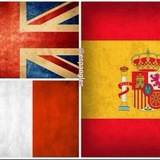#spanish #grammar
#Weather #idiom
Weather Expressions
Notes:
✏️Rmember, an idiom is an expression that cannot be immediately understood by analyzing its literal meaning. A few examples of idioms in English are:👇
🇬🇧 to "drive someone crazy"
🇬🇧 to "lose it"
🇬🇧 to be "raining cats and dogs"
✏️Spanish also has many idiomatic expressions. Although their literal translations sound odd to English speakers, they sound perfectly natural to native speakers. Here is one example:👇
Idiom: 🇪🇸 Hace mucho frío
Literally : It makes much cold
True Meaning: 🇬🇧It is very cold
✏️In Spanish, there are a number of idiomatic expressions that employ the verb hacer (literal meaning: to do or to make), and are used to describe the weather.
🇪🇸 ¿Qué tiempo hace?
🇬🇧 What's the weather like?
🇪🇸 Hace frío. 🇬🇧 It's cold.
🇪🇸 Hace calor. 🇬🇧 It's hot.
🇪🇸 Hace viento.🇬🇧 It's windy.
🇪🇸 Hace sol. 🇬🇧 It's sunny.
🇪🇸 Hace buen tiempo.
🇬🇧 The weather is good.
🇪🇸 Hace mal tiempo.
🇬🇧 The weather is bad.
🇪🇸 Hace fresco. 🇬🇧 It's brisk.
✏️Like the idioms that use tener, these idioms also contain a noun.
el frío & el calor & el viento
el sol & el tiempo
✏️Because the idioms use nouns, they are modified by adjectives, not adverbs.👇
🇪🇸 Hace mucho frío.
🇬🇧 It's very cold.
✏️There are also weather expressions that use the verb hay:👇
🇪🇸 Hay niebla. 🇬🇧 It's foggy.
🇪🇸 Hay neblina.🇬🇧 It's misty.
🇪🇸 Hay sol. 🇬🇧 The sun is shining.
🇪🇸 Hay luna. 🇬🇧 The moon is out.
🇪🇸Hay relámpagos. 🇬🇧It's lightning.
🇪🇸 Hay humedad. 🇬🇧 It's humid.
🇪🇸 Hay nubes. 🇬🇧 It's cloudy.
🇪🇸 Hay lluvias torrenciales.
🇬🇧 It's pouring.
🇪🇸 Hay un vendaval.
🇬🇧 There's a windstorm.
🇪🇸 Hay granizo. 🇬🇧 It's hailing.
🇪🇸 Hay lloviznas.🇬🇧 It's sprinkling.
✏️Other weather expressions use the verb estar along with an adjective:👇
🇪🇸 Está oscuro. 🇬🇧 It's dark.
🇪🇸 Está nublado. 🇬🇧 It's cloudy.
🇪🇸 Está lluvioso. 🇬🇧 It's raining.
✏️Other weather expressions simply use a single verb:👇
🇪🇸 Llueve. 🇬🇧 It is raining. 🇬🇧 It rains.
From the verb llover (to rain)
🇪🇸 Nieva.
🇬🇧 It is snowing.
🇬🇧 It snows.
From the verb nevar (to snow)
🇪🇸 Truena.
🇬🇧 It is thundering.
🇬🇧 It thunders.
From the verb tronar (to thunder)
🇪🇸 Llovizna.
🇬🇧 It is drizzling.
🇬🇧 It drizzles.
From the verb lloviznar (to drizzle)
✏️Here are some common ways to ask about the weather:👇
¿Qué tiempo hace?
¿Qué clima hace?
¿Cómo está el clima en ...?
¿Cómo está el tiempo?
¿Cómo está el clima hoy?
✏️The first practice exercise and test will cover ten of the most common and useful of these expressions:👇
¿Qué tiempo hace?
Hace frío. Hace calor. Hace viento. Hay niebla. Hay granizo.Hay relámpagos. Llovizna. Nieva. Llueve.
@espangles
#Weather #idiom
Weather Expressions
Notes:
✏️Rmember, an idiom is an expression that cannot be immediately understood by analyzing its literal meaning. A few examples of idioms in English are:👇
🇬🇧 to "drive someone crazy"
🇬🇧 to "lose it"
🇬🇧 to be "raining cats and dogs"
✏️Spanish also has many idiomatic expressions. Although their literal translations sound odd to English speakers, they sound perfectly natural to native speakers. Here is one example:👇
Idiom: 🇪🇸 Hace mucho frío
Literally : It makes much cold
True Meaning: 🇬🇧It is very cold
✏️In Spanish, there are a number of idiomatic expressions that employ the verb hacer (literal meaning: to do or to make), and are used to describe the weather.
🇪🇸 ¿Qué tiempo hace?
🇬🇧 What's the weather like?
🇪🇸 Hace frío. 🇬🇧 It's cold.
🇪🇸 Hace calor. 🇬🇧 It's hot.
🇪🇸 Hace viento.🇬🇧 It's windy.
🇪🇸 Hace sol. 🇬🇧 It's sunny.
🇪🇸 Hace buen tiempo.
🇬🇧 The weather is good.
🇪🇸 Hace mal tiempo.
🇬🇧 The weather is bad.
🇪🇸 Hace fresco. 🇬🇧 It's brisk.
✏️Like the idioms that use tener, these idioms also contain a noun.
el frío & el calor & el viento
el sol & el tiempo
✏️Because the idioms use nouns, they are modified by adjectives, not adverbs.👇
🇪🇸 Hace mucho frío.
🇬🇧 It's very cold.
✏️There are also weather expressions that use the verb hay:👇
🇪🇸 Hay niebla. 🇬🇧 It's foggy.
🇪🇸 Hay neblina.🇬🇧 It's misty.
🇪🇸 Hay sol. 🇬🇧 The sun is shining.
🇪🇸 Hay luna. 🇬🇧 The moon is out.
🇪🇸Hay relámpagos. 🇬🇧It's lightning.
🇪🇸 Hay humedad. 🇬🇧 It's humid.
🇪🇸 Hay nubes. 🇬🇧 It's cloudy.
🇪🇸 Hay lluvias torrenciales.
🇬🇧 It's pouring.
🇪🇸 Hay un vendaval.
🇬🇧 There's a windstorm.
🇪🇸 Hay granizo. 🇬🇧 It's hailing.
🇪🇸 Hay lloviznas.🇬🇧 It's sprinkling.
✏️Other weather expressions use the verb estar along with an adjective:👇
🇪🇸 Está oscuro. 🇬🇧 It's dark.
🇪🇸 Está nublado. 🇬🇧 It's cloudy.
🇪🇸 Está lluvioso. 🇬🇧 It's raining.
✏️Other weather expressions simply use a single verb:👇
🇪🇸 Llueve. 🇬🇧 It is raining. 🇬🇧 It rains.
From the verb llover (to rain)
🇪🇸 Nieva.
🇬🇧 It is snowing.
🇬🇧 It snows.
From the verb nevar (to snow)
🇪🇸 Truena.
🇬🇧 It is thundering.
🇬🇧 It thunders.
From the verb tronar (to thunder)
🇪🇸 Llovizna.
🇬🇧 It is drizzling.
🇬🇧 It drizzles.
From the verb lloviznar (to drizzle)
✏️Here are some common ways to ask about the weather:👇
¿Qué tiempo hace?
¿Qué clima hace?
¿Cómo está el clima en ...?
¿Cómo está el tiempo?
¿Cómo está el clima hoy?
✏️The first practice exercise and test will cover ten of the most common and useful of these expressions:👇
¿Qué tiempo hace?
Hace frío. Hace calor. Hace viento. Hay niebla. Hay granizo.Hay relámpagos. Llovizna. Nieva. Llueve.
@espangles
